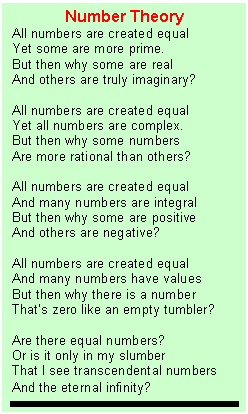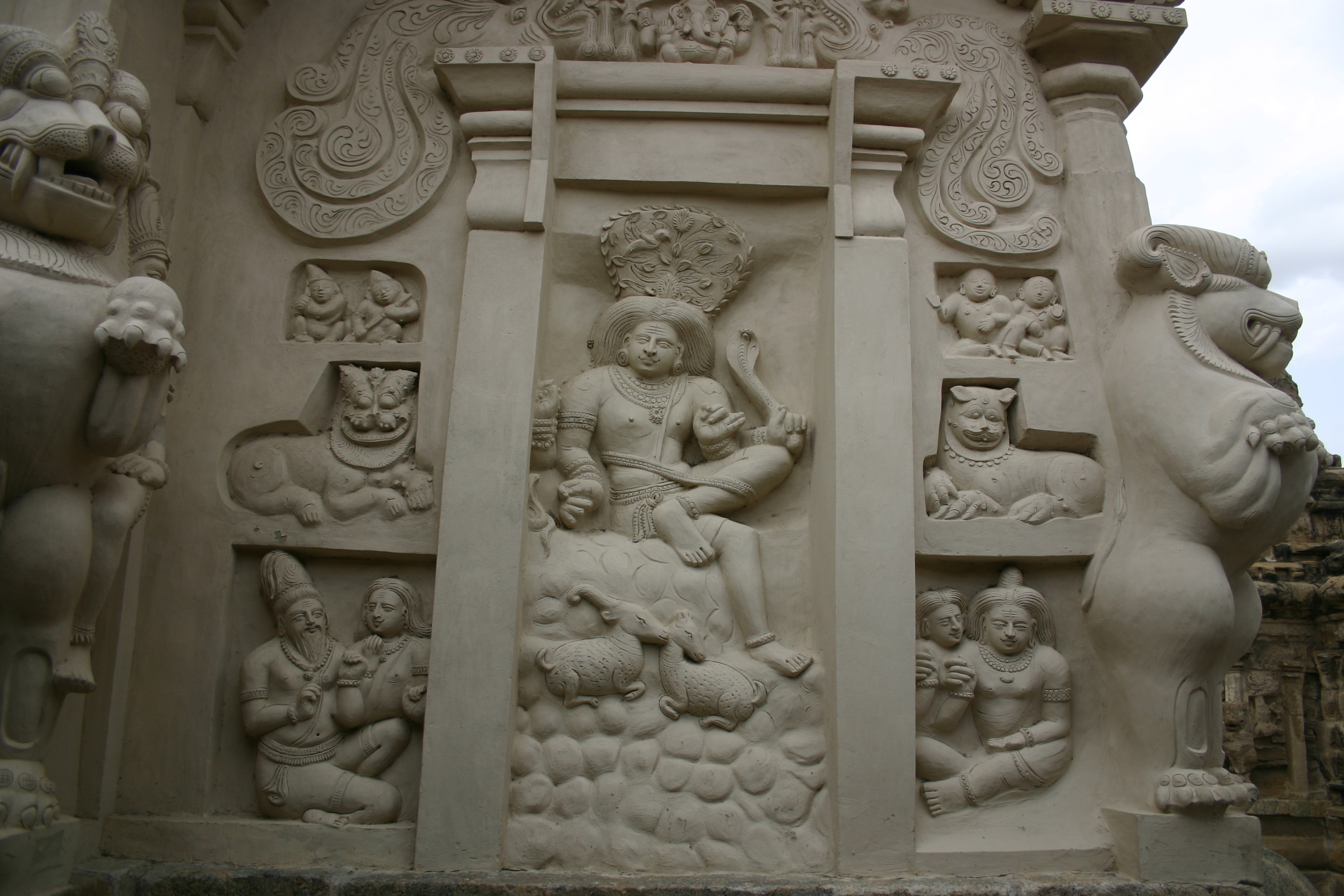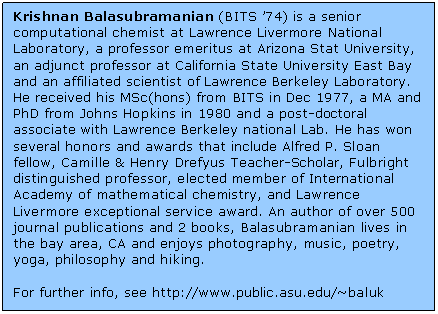|
Computational & Mathematical Concepts in Arts and Sciences
By Krishnan Balasubramanian (BITS ’78)
RD Burman’s mere nainaa saavan bhaadon, sung by Kishore Kumar and a 1982 song there mere beech main kaisa hai ey Bhandon from the movie Ek Dhuje keliy were both hits of their times and perhaps of all times. Then again, we have the song jaane kahaa.n gae vo din, 1970 Raj Kapoor’s mera naam joker.
Besides being great hits do they have anything else in common? Well
they are all similar in tune or melody, as they have a similar form in
some mathematical ways or they all derive from the same Hindustani Raga
Shivaranjani. When we tune our ears to these songs don’t we
recognize a pattern or a mathematical form of melody and rhythm? This
happens to be the topic of my recent lecture at IIT Madras.
 Professor
V. Krishnamurthy, retired deputy director and then a professor of
mathematics had a strong early influence in shaping my ability to see
mathematical and computational concepts in many fields, music,
sculptures, movies, religion, Bollywood or Kollywood music to all
branches of sciences. Professor
V. Krishnamurthy, retired deputy director and then a professor of
mathematics had a strong early influence in shaping my ability to see
mathematical and computational concepts in many fields, music,
sculptures, movies, religion, Bollywood or Kollywood music to all
branches of sciences.
One of the central
themes of my IIT lecture was such mathematical and also computational
concepts in arts and sciences as the first part of my talk. Quantifying
similarity as in patterns of nature is part of non-numerical branches
of computational science such as artificial intelligence. The field is
not only of aesthetic interest such as machine or cognitive
perception of music but also of pragmatic value such as in the
field of computer aided drug discovery and molecular similarity.
Who said aesthetics is
only for artists and not scientists or engineers? Is it not amazing
that there could be some latent mathematical form in aesthetics? Is it
possible that science and arts can really come together? Well a part of
my talk at IIT dealt exactly with that- the role of mathematical
concepts originating from symmetry, asymmetry and duality with examples
of ancient temples of Chola and Pallava of Tamil Nadu to Orissa
temples. Consider one of the slides that I used in my presentation
shown as Fig 1. This is from Kailasa Nadha temple located in
Kancheepuram, a temple town about a 2 hour hop from Chennai.

The temple stands out
as a monumental piece of sculptural aesthetics of the Pallava Empire. A
recurring mathematical pattern that emerges from many of these temple
sculptures is the union of concepts of symmetry, asymmetry and duality.
For example there is overall symmetry of the flanking dancers and yet
the niches have some asymmetry and duality built into them as if there
needs to be a global balance beyond the usual symmetry. By duality I
mean on one side you have an image of a young person and the other side
an old. Some times you find the image of a demon and the other side an
angel.
 In a more general sense I In a more general sense I
explored the role of symmetry, asymmetry and duality in India’s
versatile and rich culture, religion and philosophy. While we
understand symmetry in math as invariance under point group operations
such as rotation, reflection, inversion, and improper rotation, concept
of duality will be developed as a juxtaposition of contrasting images,
as a flanking or union of images of “demon” and
“devil” or “fire” and “water” or
“shiva” and “shakthi” so as to bring
equilibrium or global symmetry.
Mathematical and
computational Ideas were introduced in music Theory using
mathematical And computer generation of ragas. A raga as we all
know is the Backbone of melody and it is the most fundamental part of
Indian music. So how many Ragas are really there? And are there new yet
to be discovered Ragas. The answers for these intriguing questions are
in combinatorics of raga formation and enumeration. This can be done
systematically using polynomial generating functions called raga
inventory by considering various kinds of arohan (ascent) and avarohan
(decent) The coefficients of various terms in the raga inventory
polynomial enumerate the various types and numbers of ragas. Then
a computer code was developed to construct various ragas.
Finally it was shown
that there are 262,144 non-vakra or non-kinky ragas. This means the
ascent and descent have uniformly increasing and decreasing
frequencies. We have created a list of such non-kinky ragas. Good
news is ragas like shivaranjani, Bhoopali, Malkauns, charukesi,
and so on are covered by the enumeration. But still ragas such as
darbari kanada and Sri would not be included as they are vakra ragas.
My lecture then
explored quantifying similarity in the context of molecular
architecture and drug design. How does one quantify such a
qualitative or
aesthetic fetaure? One way is to develop a set of rules under which two
species can be related or even 2 ragas may become related. Once the
rules are in place one can define Euclidian types of distances between
species or molecules and then use statistical methods such as
clustering and principal component analysis.
The lecture showed
that interesting amalgamation of concepts from computer science,
mathematics, quantum mechanics, and biology could lead to some very
unique perspectives. For example, how a complex proteome of a living
organism such as rat’s liver cell can be characterized using
complex algebra and how we can develop algorithms for characterizing
such complex 2d-gel patterns of complex array of thousands of proteins
in a cell.
My second and final
part of the lecture considered Einstein’s theory of relativity
and the nature of chemical bond in very heavy elements and newly
discovered superheavy elements. Significant portion of my research
deals with applications of relativity to the chemical bonding of
molecules containing very heavy atoms. Well, we all heard that all that
glitters if not gold, did you ever wonder that gold glitters because of
relativity! Yes, you heard it right, but for Prof Einstein the beauty
of gold would have been buried into a blackish or silverfish look. The
yellow glitter of gold is attributed to relativity due to increased
speeds of electrons of the gold atom. As you admire all that
glittering golden jewelry, pay a tribute to Einstein for his landmark
papers on relativity. As we keep discovering new elements, many of them
yet to be named such as 114 and 115 discovered at Lawerence Livermore
National Lab, relativity becomes more and more important as the speeds
of electrons of these elements increase resulting in a parabolic
relativistic effect as the atomic number increases. I showed some
exciting new properties of such very heavy species as a result of
relativity.
Look
at the breadth of topics that I was able to speak on, aesthetics,
sculptures, music, duality, similarity, relativity, quantum mechanics,
bioinformatics, and of course quantum chemistry. How in the world did I
manage to talk about the theory of Hindustani and carnatic music to
pallava architecture to relativity to drug design-all in one
lecture? As I deeply ponder over this question, I transcend back
in time to India, to Pilani and vividly recollect the beautiful
saraswathy mandir and the BITS clock tower. That is the beauty
and versatility of the education that we have received as students of
BITS. The greatest boon that one can get to face the modern world
filled with such plethora of interdisciplinary topics is truly a
multidisciplinary and broad education that Pilani offered to us and
continues to offer. I ended my talk with a poem that I published in the
Journal of Mathematical chemistry that summarizes a unique
interdisciplinary culture that BITS cultivates.
¨
|

